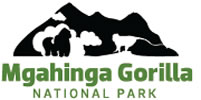Start here for basic information about the Mgahinga Gorilla National Park. Learn where Mgahinga National Park is in Kisoro District of Western Uganda. Find answers to the most frequently asked questions such as what to pack and how close you should get to wild animals. Are you planning a trip far in advance? Check our weather articles to learn what to expect in different seasons. And, don’t forget to check our park map.
Mgahinga Gorilla National Park was established on May 9, 1991, following a long history of name and boundary changes. It is located in the southwestern corner of Uganda and is the smallest park in Uganda with an area of 33.7 km². It contains a range of montane forest and non-forest vegetation, a range of animal species (including the golden monkey, elephants, buffaloes, duikers), and is visited frequently by groups of mountain gorillas which cross the border from the adjacent national parks in the Democratic Republic of Congo (Parc National des Virunga) and Rwanda (Parc National des Volcans).
The park consists of the Ugandan slopes of three inactive volcanoes: Muhavura, Gahinga and Sabinyo. Due to El Niño, the park and its surroundings experienced a very wet season, with the highest peak of rainfall from December 1997 to February 1998. In April 1998, there were reports of several deaths of people who were swept away by run off from the slopes of the volcanoes. On April 13, 1998, a child of our porter drowned in a heavy downpour of rain.
Size:
Mgahinga National Park is 33.7km in size and this makes it the smallest national Park in Uganda.
Why Mgahinga Name?
This park takes its name from Gahinga which is a local word for the piles of volcanic stones cleared from farmland at the foot of the volcanoes.
History of Mgahinga National Park
Mgahinga Gorilla National Park is the smallest of all Uganda’s national parks. The park was created to protect the mountain gorillas that roam freely within the Virunga region. The park is bordered by the Virunga National Park of the Democratic Republic of Congo and the Volcanoes National Park of Rwanda. It was declared a game sanctuary by the British administration in 1930 and was gazetted as a national park in 1991. The park has only got one habituated trans- boundary gorilla group. The visitors can also enjoy the Batwa visit which is a much far fascinating tour with the Batwa guide to learn the secrets of the forest. The park’s star attraction is the mountain gorillas.
About the Park
Mgahinga Gorilla National Park is one of the luckiest and smallest parks in Uganda where the world’s critically endangered mountain gorillas are found and it happens to be part of the Virunga massif where more than 480 mountain gorillas park known to be living.
The park sits high in the clouds, at an altitude of between 2,227m and 4,127m. As its name says, it was created to give protection to the mountain gorillas that live in its dense forests, and it’s also an important habitat for the endangered golden Monkey. The national park has cultural significance, in particular for the indigenous Batwa pygmies. The tribe of hunter gatherers was the forest’s first people. Mgahinga has got the most striking features and its conical, extinct volcanoes that are part of the spectacular Virunga Range which lies along the border region of Uganda, Congo and Rwanda.
The national park also forms part of the much larger Virunga Conservation Area that includes adjacent parks in these countries. The volcanoes slopes have got many ecosystems and are biologically diverse and their peaks give a striking back drop to this gorgeous scenery.
Out of the mountain gorilla population that are found in the Virunga Massif, there are about 3 gorilla families that are known to be living in Mgahinga Gorilla National Park.
Location:
The park is located about 519 kilometers from Kampala and it is a 9-10 hours’ drive.
Wildlife
This park was home to the Nyakagezi group of the rare Mountain Gorilla (Gorilla Gorilla Beringei,). This family moved into a territory in Rwanda in 2005 which saw the the cessation of Gorilla tracking activities at Mgahinga. The group does retrun to the reserve for periods of time where visitors wishing to visit this group can obtain permits only on the day of tracking. Other animals in the area include the golden monkey (endemic), giant forest hog, bushbuck and buffalo.
Climate and Weather
March, April, May and October to November are the 5 wetter months of the year, the months when the park experiences heavy rains and the ground often becomes slippery or muddy. The park’s temperature rise differs with altitude, with average day temperature of 20 degrees celsius and at night, there is a drop of up to 9 degrees celsius. At each elevation of 1000 meters, there is a drop of 6 degrees celsius.
Vegetation
Mgahinga gorilla national park’s volcano slopes contain varied ecosystems ranging from the montane woodlands, tropical forests and bamboo, moorland and tree heathers to the rare afromontane vegetation. Hence the park is ever wet and covered by mist; visitors need to prepare for damp weather conditions.
